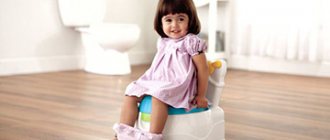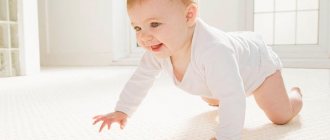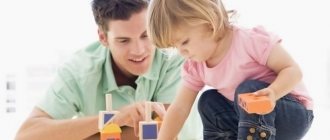Quite often, parents are faced with the fact that their child does not want to poop on the potty. There are many reasons for this behavior and you need to correctly recognize them and take appropriate measures. Often the parents themselves are the culprits of this behavior, and their reaction to what is happening is fundamentally wrong, which again they themselves only aggravate the situation and develop complexes and various kinds of fears in the child, as a result of which he refuses to poop in the potty. You can also encounter situations where the baby already pees in the potty on his own, but doesn’t want to poop in anything. This situation is quite common and usually occurs in children aged 3 years. So let's look into it and identify the very reasons why your child does not want to poop on the potty, as well as what actions need to be taken.
ATTENTION!!!
Under no circumstances should you scold your child for not wanting to poop in the potty or focus attention on this. You may create negative associations with the potty, and he may begin to think that pooping is something shameful.
How to start?
Let's imagine that an adult was taken out of town and forced to build a house from what was under his feet.
At the same time, they did not give any tools, but only pointed with their finger where the house should stand. The baby understands the same thing when adults want something from him.
He doesn't understand half the words he hears, but he must do as the others wish. This leads to stupor, fear and hatred of the potty. This may seem like a harmless event, but the child will experience discomfort from childhood.
And then a preschool, where children do this on their own. And there's school ahead. Embarrassments happen, but if the baby is withdrawn, there will be big troubles. Therefore, step by step, you need to track where the baby is going in order to do your big things.
Therapists assure that the baby may be uncomfortable from the sensations when the process of defecation occurs while sitting.
Doctors advise learning to potty train no earlier than a year. How to teach a child to ask to use the potty so that it is not a burden for the baby and parents?
Choosing a device for transporting a child. We will evaluate all the pros and cons of infant carriers and car seats for newborns here.
You will find tips on potty training your child starting from one year of age below.
What to do when embarrassed?
When a baby does not allow himself to be put on the potty, under no circumstances should you hold him back.
If the child is used to doing this while standing, you need to wait until he himself wants to try his hand at a different position. Also, in such endeavors, the baby may cry.
This is associated with painful sensations.
The mother can try using a glycerin suppository if the baby is unable to concentrate on the process for a long time. The urge will come, and he himself will do everything that needs to be done in the potty.
When everything happens, the baby must be praised and perhaps encouraged in some way for his great endeavors. We need to show him that adults experience joy in such victories.
Getting to know natural physiology is also an important and educational process of the entire event. It is necessary to show the child his final result of digestive activity. If he wants to touch the contents of the pot, help in cognition. You should wash the pot together, and then he will no longer be afraid of his actions.
Any violence against the will of the child may later manifest itself as neuroses.
A child poops while standing: recommendations
I have already written about my observations of cases when a child is aware of his urge to defecate, but does it exclusively while standing and wearing a diaper. I have written recommendations for you that, when worked systematically (please pay particular attention here), will help a child with sensory integration disorder.
So, the situation: a child poops only in a diaper, but at the same time has basic communication skills (that is, he is able to signal his desire). He can pee in the potty.
Goal: teach your child to poop in a potty.
What is necessary for a child to master this skill:
- Good postural control (i.e. sufficient integration of proprioceptive and vestibular information, ability to maintain a stable upright position while sitting on the potty using one's own muscles);
- Perception of one’s own body outside and inside (localize sensations, selectively control the pelvic muscles);
- Having an example is social learning;
- Ability to dress and undress;
- The ability to learn and apply one's own experience.
As we can see, a lot is connected with sensory integration (the first two points are key). One of the manifestations of proprioceptive search is tiptoeing (tactile hypersensitivity is also possible). Due to prolonged tiptoeing, the child secondary develops hypertonicity of the calf and gluteal muscles, which also makes it difficult to sit on the potty (and the child already has insufficient postural control to begin with). But the child does not necessarily walk on tiptoes; he may have problems with bowel movements without it.
What can you do at home to help such a child:
- Firstly, do not scold, do not neuroticize the child under any circumstances and be patient.
- Buy a comfortable potty that is sized with a back so that the child can sit comfortably and comfortably in a relaxed state (since it is difficult for the child to maintain postural control).
- We offer the potty regularly and systematically (morning, before a walk, after a walk, before bed, etc.). No pressure or manipulation. Allow your child to be alone with the potty (children often hide when they poop). Do not use the potty for play. Set an example of proper toilet use (your own or older children can do it).
- Use a weighted vest (the weight of the vest should be 10-25% of the child’s weight) several times throughout the day - during meals, during walks. We wear it until the child asks to take it off. After a while we put it on again. This is proprioceptive stimulation. As an alternative, you can use a backpack, put on backwards, where you put, for example, water bottles.
- We are training to climb up the hill in reverse - along the part where they slide down (I hope I wrote it clearly). This is proprioception and stimulation of those muscles that give “chicks”. That is, an exercise for children walking on tiptoes - a must do, as they say.
- Bathing in pajamas (yes, we get into the bath with our clothes on). This is proprioception. You can use a special jelly for bathing (sold by Ozone).
- Obstacle course game - we play every day. We lay out cushions from the sofa at home, turn over chairs, etc. The child needs to go through obstacles.
- Trampoline or jumping on the sofa (attention to the safety of the child!). Trampoline, paradoxically, is also primarily a work with proprioception. And here it is important that the child learns to group, predicting the movement of his body. Tension the muscles selectively, which is necessary for successful bowel movement.
- "Hard work". We give the child games and tasks around the house, including dragging heavy things. A change of bed linen will also do.
- Game "Horse". We ride the child on our back. This is training in the work of different sensory systems, selective control of different muscle groups, and work on postural control. The same functions are provided by riding on the shoulders.
- “Sandwich” and “sausage in dough”. In the first case, we place the child between two elastic pillows and press evenly. We create an obstacle so that the child gets out with effort. In the second, we wrap it in a weighted blanket or foam mat, and then unwind it little by little.
- Swing games.
- Bandaging with elastic bandages (start with the body and groin, then the arms). We take it off when the child asks. You can do several “entries” every day.
You can also use taping of areas on the calves and buttocks to relieve hypertonicity, but I do not recommend doing this on your own; I can do it during an in-person visit. Bring the tape with you.
These games and techniques are suitable for most children with sensory integration disorders. Can be used not only for problems with the potty. It is important not to force the child, but to play, so that it is a joy. If the child does not accept, screams, resists, do not use such a game. And of course, in case of any difficulties, consultation with a specialist is advisable.
Neuropsychologist Alexandrova O.A.
To schedule a consultation with a specialist, call or fill out the application form on the website.
You can also contact us through popular messengers:
Why don't kids want to poop in the potty?
The problem is trivial and is associated with physiological characteristics. Doing this while standing is much more convenient - the colon relaxes.
There are also a number of points to pay attention to:
- Constantly wearing a diaper. Children who wore diapers around the clock have a harder time parting with their clothes. If at 6-8 months the child did not have the opportunity to get to know his body, then at 2 years it will be more difficult to master the potty.
- Constipation. If the baby has difficulty going to the potty, he will have a “potty-hurt” connection, and further use of it will come down to the perception of something unpleasant.
- Dominant parents. This is due to their excessive control. It will be difficult for the baby to do something on his own due to constant supervision. Mom or dad needs to be given a little freedom so that the baby can make decisions on his own.
The parents' task is to show the child that there is nothing wrong with this. In some cases, tricks help:
- The child “went” into the diaper. The task of parents is to clearly show the behavioral features of this process. Line up the logical actions of his actions and put everything in its place. The child should show interest in this and repeat the action of adults in a playful way. When it comes to poop, it should be in a pot. Let the baby repeat the whole process in accordance with the belonging of the objects.
- Panties. Panties are a must if the baby can walk small. By and large, it will be easier for him, knowing that he needs to take off his clothes. This way the mother can control when the baby wants to poop. Urges are boasted.
- If at the time of potty training the process is difficult, you must definitely show the baby his underwear, with a little reproach for what he has done. You should always talk to him about this - not harshly, pointing out shortcomings, but only at his eye level.
Minimal and light clothing, without diapers, will help check the child’s reaction and promptly signal his temporary needs.
A child’s understanding in many respects depends on adults. Some people have the gift of explaining things well; children are drawn to such people. If communication does not work out, there is nothing terrible about it - the baby may not yet perceive serious conversations. You need to try, starting with talking with peers about how they went through such situations.
Parents are puzzling over how to quickly potty train their child. A few helpful tips will help you cope with this task.
Read about the features of choosing a cane stroller for twins on this page.
So, to summarize, we note that the child may not experience any strong emotions if you correctly show him what it means to relieve himself. Mom especially needs to be patient because children never want to learn anything.
For calm lessons, use fairy tale therapy, role-playing games and story-based activities. Using the example of his favorite toys, the baby will also want to play interesting games. Mothers take note - do not lose or miss the opportunity to see how the baby learns and what discoveries he makes for himself.
Great post about potty training
Today I’ll tell you about the experience of potty training a child. The topic is sensitive, so, sorry, no cuts. “With the laptop on the potty, it reminds me of someone.” Everything written below is solely my theory and experience, I do not encourage anyone to do anything. When to start potty training?
There are 2 opposing opinions:
1.
Start training
as early as possible
: run after the child with a basin, the result will be the described apartment, clothes, shoes, toys, car seat, etc.
2. Do not raise the topic of the potty at all until one and a half
, because
“Psychologists say that starting earlier is pointless,” but I’m lazy. For me, the truth, as usual, is somewhere in the middle. For some reason, people who choose the first opinion, when talking about potty training, mean learning to pee in a potty. In my opinion, the two main processes have completely different semantic and physical loads. Pooping is not easy, sometimes it takes a few minutes to get the job done. You need to focus on the process. Happens infrequently, usually 1-2 times a day. Writing is easy, you don’t need to put in any effort. The process itself is very fast, less than a minute. Happens quite often. The moment when a child understands that he needs to restrain himself and not pee his pants, in my opinion, is really individual, usually this happens around 2-3 years. This is precisely the development and basic skills of the child, like being able to walk or talk, each child has his own time, and there is no need to rush things. Therefore, in short, my theory: teach the child to poop in the potty as early as possible, wait and help him understand when he will control his bladder Our result:
the first at 7-8 months, the second at 2 years.
Now about everything in more detail. The Soviet legacy is in the minds of many grandmothers and even doctors about the timing of training.
Many people think that at the age of one and a half, a child should already be able to do everything.
Potty training becomes an obsession, and even elements of bragging along with early development and other achievements. Life used to be, frankly speaking, bad. There were no normal diapers, and there was no money. Now, by the way, too, many early adopters choose this path because of savings, so as not to buy diapers. Don't give in to provocations! It’s you, your experience, and another time, and if it’s expensive for you to buy diapers, then stop buying them offline, buy online, there are always options for saving (bonus points, promotional codes, sales, etc.) Choosing a good potty 1. Height pot
This is a very important point.
Unfortunately, our selection of pots is very small; in the children's departments of shopping centers there are mainly samples from domestic manufacturers, i.e. ill-conceived and very economical. The main problem with this saving is not even the cheap plastic, but the height of the pot
!
Think about it, how do you sit on the toilet? That’s right, like on a chair, your legs bend at 90 degrees and stand flat on the floor, so why are our children offered to buy a potty, sitting on which the child’s legs will be extended in front or strongly bent at the knees? 2. Potty size
Yes, the child is growing, and his butt, sorry, is also growing.
We had 2 pots, in the photo below is our first pot from Rotho
, I ordered it from Germany for ~13 euros when I was still pregnant. It is comfortable for a small child to sit there, legs at 90 degrees. Analomic shape, back support, wide rubberized base, removable insert, cute picture with Winnie the Pooh. Ideal potty for children under one year old.
The child switched to the second potty around the age of one year (See the title photo in the post).
We bought it on the last day of our trip to Spain, it is from a local company, Voltereta. This is a tall potty with a high back for older children. The insert is also removable; the rubberized base prevents slipping. Our potty also had a lid that turns the potty into a high chair. Honestly, we have never used it, so I think it’s worth paying attention to the presence of this thing. I’ll tell you about its analogues of the BabyBjorn potty chair
myToys.ru akusherstvo.ru ozon.ru In fact, I wanted this particular potty, but in 2013 it was impossible to find it in the Russian Federation for less than 2000 rubles, so we bought a high-quality Spanish analogue.
This is a world-famous brand; reviews can be found on Amazon. If you decide to buy this potty for an older child, then do not buy the second model, without a back, it is much lower and smaller. There is an analogue of this pot, which costs several times less, only made of cheaper plastic, but designed similarly. Potty Russia Little king
akusherstvo.ru ozon.ru my-shop.ru (I’ll give a link to the blue one, if you look at the manufacturer, there will be other colors)
Part 1. We teach you to poop in the potty Why do we teach you to poop? 1.
It’s easier for a child to poop in the potty than, for example, doing it while just sitting on his butt or standing
2.
Washing his butt after doing it in the potty is MUCH easier than when it’s all smeared.
All you need is a damp cloth, and you don't have to lift a heavy baby to wash him in the sink. 3.
Pooped diapers smell very strongly, especially when the child grows up, you need to buy a disposal or smell it, and the potty can be quickly taken out and washed.
4.
After the child understands that the results of digestion go into the potty, it is easier for him to understand that he also needs to write there, thereby he “communicates” with the potty for the first time not at 1.5-2 years, but much earlier.
My experience of teaching a child to poop in a potty
At 7-8 months, the child no longer poops spontaneously, but according to a certain schedule.
This usually happens in the morning or after a big meal. Of course, he still cannot say that he wants to poop, but he can show it: he grunts, farts, etc. At one of these moments, I put him on the potty, and lo and behold, he pooped there. Later, I began to put him on the potty at the moment when he HAD to poop, but of course a child is not a clock, there are always exceptions. Then, in order for him to poop, I began to show with my facial expressions how hard I had to try to get the job done, while I repeated “a-a-a.” You understand that this “ah-ah” is not an opera singer’s song, but something similar to grunting. After some time, he remembered this sound, I began to dilute it in half with the word “poop”, and then completely eliminated it, because I began to clearly understand the word “poop.” Of course, in order for the child to sit on the potty and do his job, the mother must be nearby, set him up for the result and entertain him with toys; we had special “potty toys”. A mandatory requirement for such a toy is that it must not be musical and without buttons; usually these were some kind of sorters and something based on logic, i.e. a toy that helps you concentrate and not get distracted, like a musical one. After the child has done the job, he should be slightly praised. ) Around the age of one and a half years, the child has matured to the point where you don’t need to sit with him, you just need to help him take off his pants, he will sit on the potty with toys by himself. Part 2. Learning to write Prevention: control of fluid entering the body
No matter how trivial it may sound, the less a child drinks, the less he pees.
Do not introduce your child to sweet tea, compote, juice, etc. To quench your thirst - only WATER. In such a situation, the child will drink as much as he needs, and will not drink only to enjoy the tasty treat. He will never drink more water than he needs. The first time we refused a diaper was for sleep, because... I don’t give my child, like many, “half a liter of liquid at bedtime,” he drinks a little, half a cup at most, this is enough to last him until the morning and go to the potty. Training panties
I bought several different types of panties and was even going to review them.
In theory, these are multi-layer panties, the child pees in them, they get wet, but not like single-layer panties, and they retain some of the liquid. The child understands that “wet = bad” and thinks that it would be nice to pee in the potty. In reality, it turned out that these panties were not needed. When he wrote in them at one and a half, there was no understanding even close. Also, most types of these panties have a waterproof layer, essentially in oilcloth; the child gets quite hot in such panties. Now I only use panties that consist of several layers of cotton; I wear them sometimes to be on the safe side. My experience in teaching a child to pee in a potty
(I started training around one year and 10 months)
Usually after two sleeps, night and day, the child wants to write. I started putting him on the potty and he peed. He also wrote after meals, at times of big business. It turns out that they have already been in the potty consistently 3 times. At night, as I wrote above, he did not write. He himself stopped peeing on the street and began to restrain himself. All that remains is to let him understand that he also needs to pee in the potty 1-2 times a day. I took off my diaper at home. He peed on the floor, I told him in the Gippenreiter style, “I get very upset when people pee on the floor,” took him by the hand and showed him that he should do it on the potty. He understood almost immediately, but I still wore a diaper to be on the safe side. Exactly at the age of 2, on a trip to the sea, he abandoned the diaper himself. At 2 years and 4 months, he still cannot speak, but when he wants to write, he points his finger at the causal place, and I myself understand when he wants to.
Misses
If there is a sharp change in temperature (from the house to the street, where it is -10), then the child may spontaneously urinate, it happened a couple of times.
For such situations, now I always try to carry a spare set of clothes and shoes with me. Alternative options
There are children who refuse to go to the potty and go straight to the toilet with a nozzle, and there are boys who only pee while standing. Maybe these boys will like this thing
Happy baby urinal in ozon.ru
Learning for the future
1. Learn to go to the toilet with a nozzle 2. Learn to pee somewhere other than the potty - “in the bushes”, in the toilet in the store, etc.
While my son is against these options, I don’t insist, he will mature. The main rule of potty training a child, as you understand, is not to force










